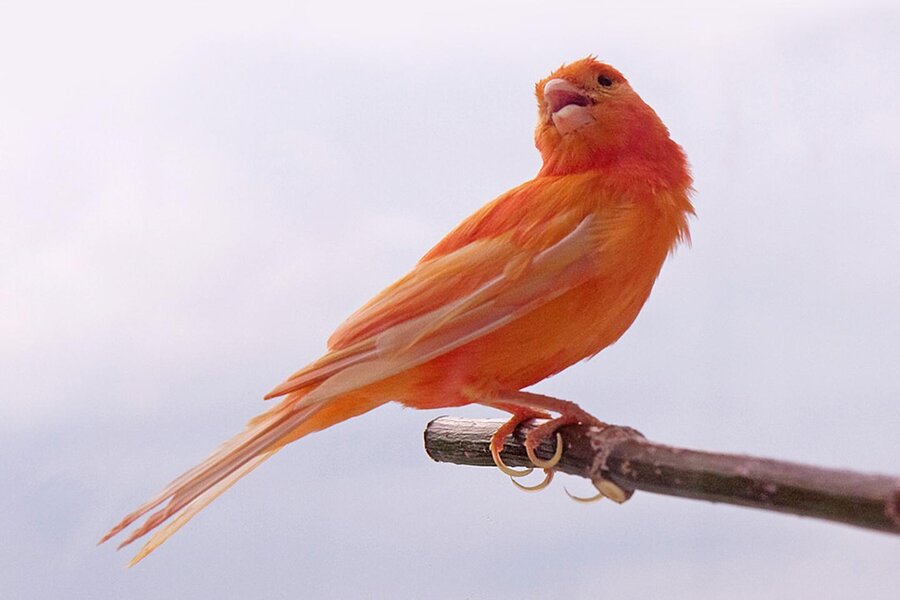Why birds are red: Secrets of scarlet revealed in matching studies.
Loading...
The redness of birds is a subject that has intrigued scientists for decades, leading, in fact, to what many regard as the first example of genetic modification: the red factor canary.
Color variation in general has long fascinated evolutionary biologists, but the color red is of particular import: relatively rare, sometimes a burden – yet also bestowing benefits, especially in the mating scene.
Now, in a display of rather cosmic coincidence, two research groups have published results of separate studies delving into the genetics behind red coloration: both published Thursday in the journal Current Biology, both highlighting the same gene responsible for red coloration.
" 'Why are birds red?' is about as fundamental a question as one can pose about nature," says co-author Geoffrey Hill, an ornithology professor at Auburn University in Alabama, in an email exchange with The Christian Science Monitor.
Dr. Hill, who has been studying red coloration in bird plumage throughout his entire career, focused his efforts on the canary, specifically the red factor variety. So renowned is this bird in the scientific world that an entire book has been written on the subject, entitled "The Red Canary: The Story of the First Genetically Engineered Animal."
The tale begins many centuries ago, when European explorers first stumbled across wild canaries. The birds proved popular, and hundreds of years of breeding yielded myriad hues of plumage. But red never featured.
Enter some German breeders in the early 20th century, determined to develop canaries of this elusive color. To aid their cause, they borrowed the services of a South American bird, the red siskin, breeding it with canaries. Over many generations, breeding the hybrid offspring with pure-bloods, they gradually produced canaries with red plumage, eventually leading to the red factor canary of today.
"Red is usually an advertisement, but it's highly visible and likely costly, easily made out by predators," says Julia Schroeder, a professor of ecology and evolution at Imperial College, London, who was not involved in either study. "So we don't see it that often in animals."
Of particular interest to Dr. Schroeder, as she explains to the Monitor in a phone interview, is what this latest research teaches us about the coloration of beaks in zebra finches, the subject of the second paper, which tend to vary through shades of red and yellow.
Ever since the publication of a 1987 paper entitled "Bill Color Preferences of Zebra Finches," which concluded that females prefer males with the brightest, reddest beaks, the subject has been soaked in controversy: try as they might, other researchers had struggled to replicate this study's results.
And if red bills were so very beneficial, says Schroeder, "we would expect, given time, that there would be only red." Other colors would fade away, unable to compete. But such is not the case. The yellow beaks remain.
All in all, there has been much confusion. The hope, therefore, was that an exploration of the genetic basis for red coloration could yield some clarity.
It all begins with carotenoids.
"All birds need yellow carotenoid in their diet," Nick Mundy of Cambridge University, England, the lead author of the paper examining finches, explains in a phone interview with the Monitor. "In order to display red pigment, this carotenoid is converted into ketocarotenoid."
So it was that both groups of scientists considered the genetic basis for this conversion of yellow carotenoid into red ketocarotenoid. And both studies yielded the same result.
"It is very satisfying that a second research group identified the same gene but in an entirely different species and tissue (beak instead of feathers)," Joseph Corbo, a researcher at the Washington University in St. Louis who was involved in the canary study, tells the Monitor in an email. "This finding is important because it indicates that the 'redness' gene we identified, CYP2J19, is likely to be widely used to make red feathers in a diversity of species and tissues (feathers, beaks, skin etc)."
And understanding the genetic pathways that mediate red coloration in birds "opens new pathways for understanding the function and evolution of red coloration in animals more generally," which is important because it is so often associated with dominance and mating success: "the redder the feathers, the more successful the animal," he added.
Indeed, Dr. Mundy and his colleagues investigating the finches think they have found at least part of the answer. The gene involved in converting yellow carotenoid to red ketocarotenoid belongs to a well-known family of genes, one with an integral role in the breaking down of toxins.
"So we have a new hypothesis," Mundy says. "What it is that makes a red bird better than a less red one? What drives female choice? There is a link between brightness of red coloration and how good they are at detoxifying any nasty chemicals they’d pick up in their diet."
There are many new pathways open to further research, now we have this fundamental understanding, and Mundy is already deep in the throes of one such journey, moving beyond the captive birds that have so far been the subject of study.
"Now we're taking this into the wild, looking at African seed-eating birds: widowbirds and bishops," says Mundy. "Bishops in particular have very spectacular, bright plumage, with lots of variation between species."








